Birdfinding.info ⇒ A rare, little-known, localized beach-dweller that was long overlooked due to its similarity to closely related species whose ranges overlap with it. White-faced (a.k.a. Swinhoe’s) Plover is a locally common breeder at a few sites in southern China, especially at Dahu Beach in Guangdong. In winter, it has be found in small numbers at a few scattered sites in Southeast Asia, including Laem Pak Bia, Thailand. (For a discussion of its taxonomic status, see Notes: “Frontiers of Taxonomy: Does the White-faced Plover Qualify as a Separate Species?” below.)
White-faced Plover
Charadrius dealbatus
Family: Charadriidae
Breeds in south-coastal China and Vietnam. Winters along coasts of southeast Asia. Its range and status are poorly understood because it went unrecognized throughout the 1900s.

Approximate range of White-faced Plover, though it is not known to occur inland. © BirdLife International 2016
Breeding. Has been found breeding in locally high concentrations on a few sandy beaches in Fujian and Guangdong, China. Also reported breeding on beaches of south-central Vietnam.
Nonbreeding. Sandy beaches of Indochina from northern Vietnam (possibly also Hainan) and Thailand south along both coasts of the Malay Peninsula and the eastern coast of Sumatra.
Movements. Northbound migration occurs mainly in February and March. Returns to wintering areas around November.
Some post-breeding dispersal, at least on a small scale, has been noted during late summer and fall. Occasional strays have been found on Taiwan.
Identification
White-faced Plover is very similar to the much commoner relatives that occur with it, the Kentish and Malaysian Plovers. Compared to those species, White-faced has a whiter face, so its eye is much more prominent.
In all plumages, the upperparts are a pale sandy color that is slightly brownish. In nonbreeding adults and immatures, the crown is mostly the same color as the upperparts, separated by a white neck-collar, and with extensive white on the forehead and forecrown.
In breeding adults, the crown is mostly a pale but vivid shade of rufous. This fades and turns sandy during the breeding season.
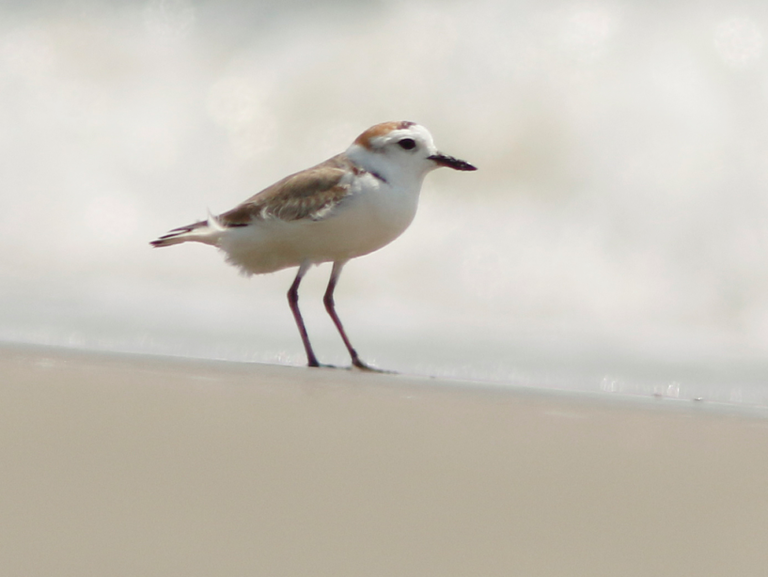
White-faced Plover. (Laem Pak Bia, Phetchaburi, Thailand; March 1, 2016.) © David Beadle
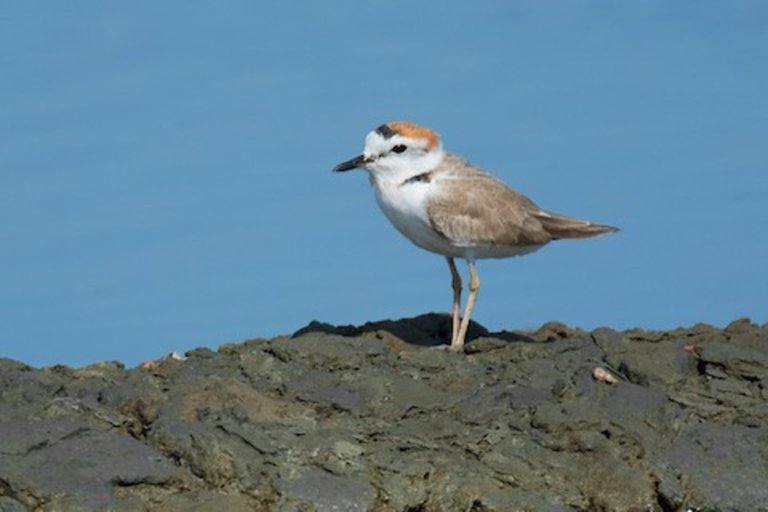
White-faced Plover, male in breeding plumage. (Laem Pak Bia, Phetchaburi, Thailand; April 8, 2017.) © Ayuwat Jearwattanakanok
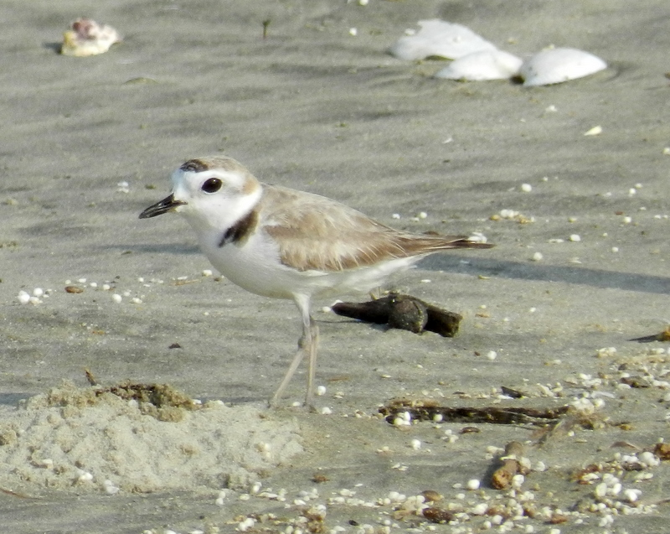
White-faced Plover, male in faded breeding plumage, with no rufous on crown. (Guangdong, China; May 2011.) © Brian Jones
Most individuals show at least a partial eyestripe, especially behind the eye, that is approximately the same color as the crown, but this varies. A few individuals have entirely white faces, while at some molt stages, many individuals show a smudgy, blackish patch around the eye—and thus become harder to distinguish from Kentish.
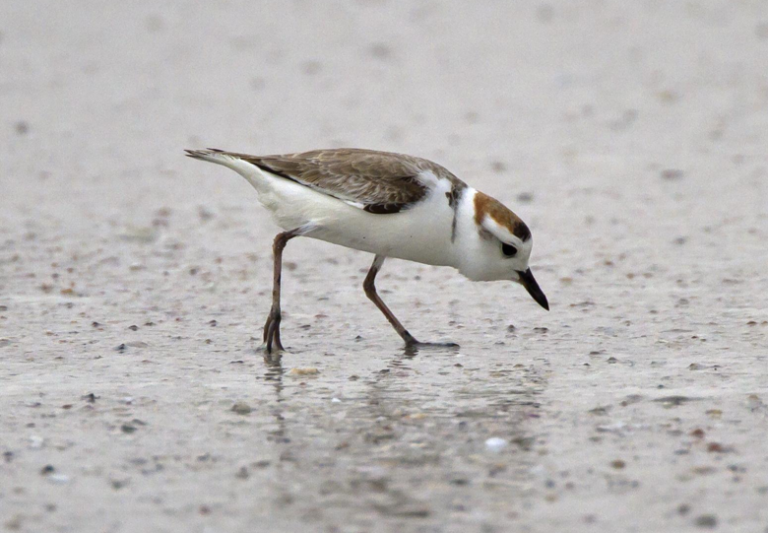
White-faced Plover, male in breeding plumage. (Laem Pak Bia, Phetchaburi, Thailand; March 9, 2013.) © Marco Valentini
Males in breeding plumage develop a few black markings that vary in intensity and extent: a bar across the middle of the crown; a bar on the side of the chest at the base of the neck; and in some also a partial black eyestripe.
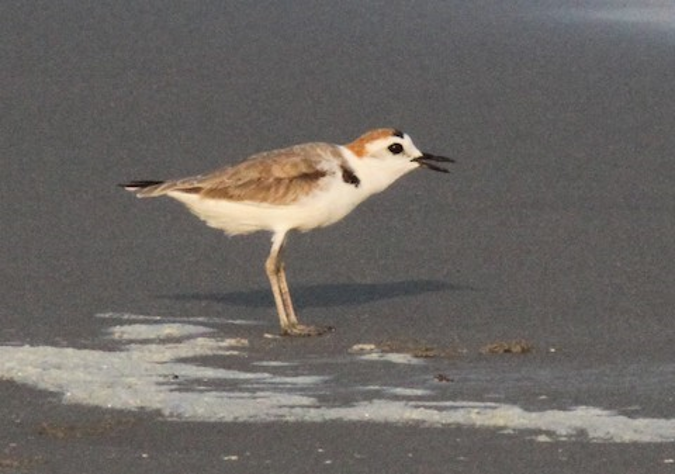
White-faced Plover, male in breeding plumage showing typical black markings. (Laem Pak Bia, Phetchaburi, Thailand; March 2, 2019.) © Sea Williams
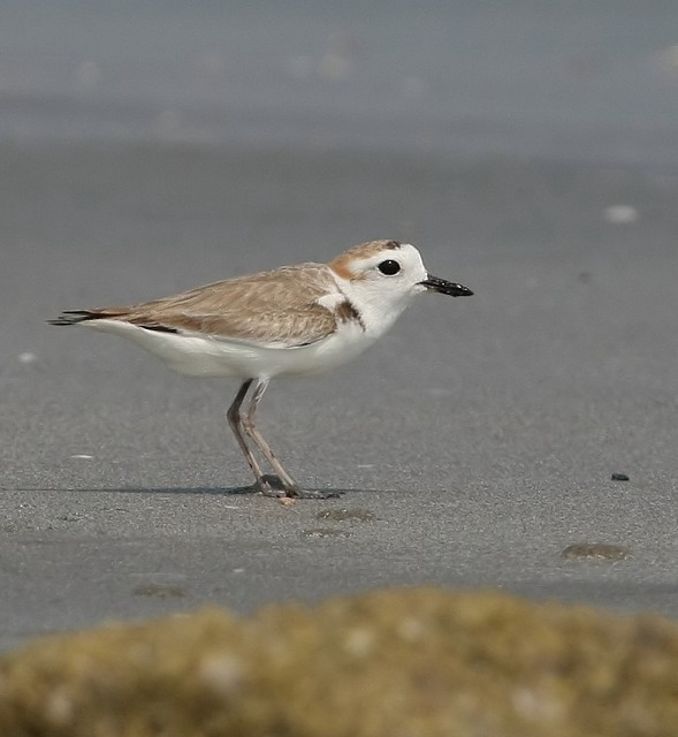
White-faced Plover, male in breeding plumage showing limited black markings. (Thailand; March 1, 2016.) © Roger Wyatt
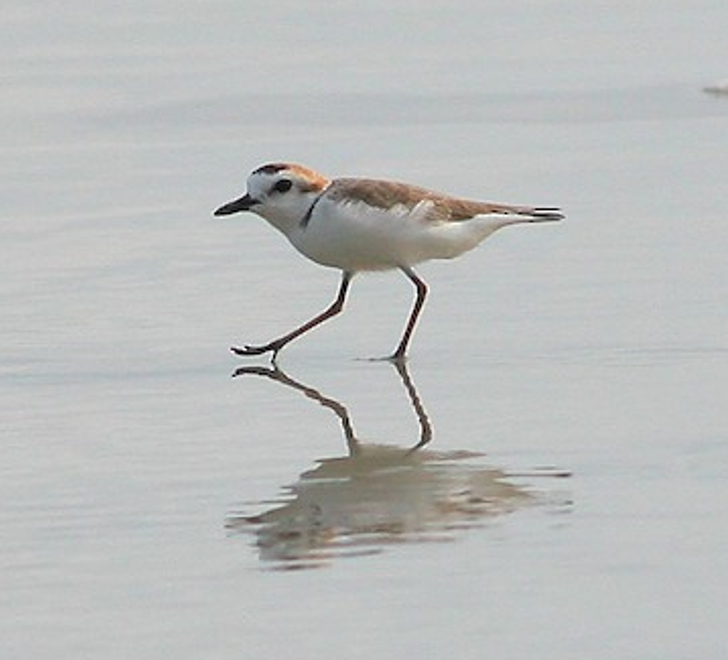
White-faced Plover, male in breeding plumage. (Khanh Hoa, Vietnam; February 8, 2016.) Anonymous eBirder

White-faced Plover, possibly a first-year male entering breeding plumage. (Laem Pak Bia, Phetchaburi, Thailand; February 2, 2018.) © Kris Webb
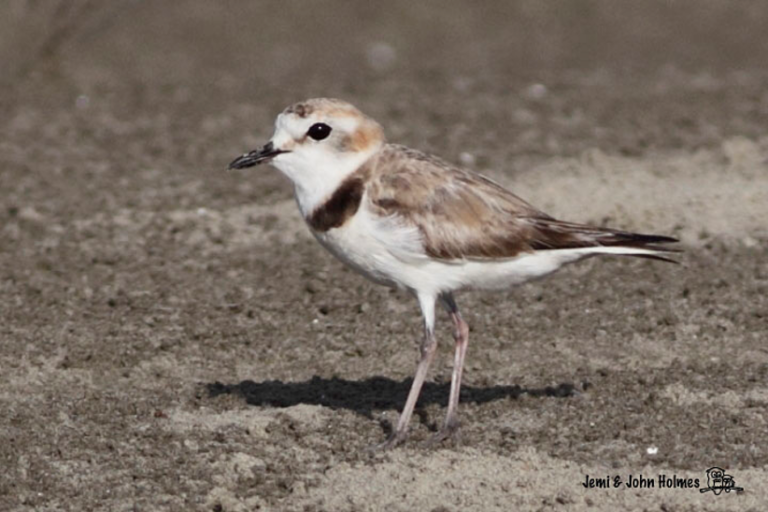
White-faced Plover, male in breeding plumage with unusually thick and long black bars on the chest. (Dahu Beach, Guangdong, China; June 2011.) © Jemi & John Holmes

White-faced Plover, male in breeding plumage showing black bar on crown and white neck-collar. (Laem Pak Bia, Phetchaburi, Thailand; March 2, 2019.) © Sea Williams

White-faced Plover, male in faded breeding plumage showing darker-than-average eyestripe. (Fuzhou, Fujian, China; July 2012.) © Terry Townshend

White-faced Plover, female in breeding plumage showing somewhat darker-than-average upperparts. (Dahu Beach, Guangdong, China; June 2011.) © Jemi & John Holmes

White-faced Plover, apparently an immature or female in nonbreeding plumage. (Rawai Beach, Satun, Thailand; November 17, 2017.) © Ayuwat Jearwattanakanok
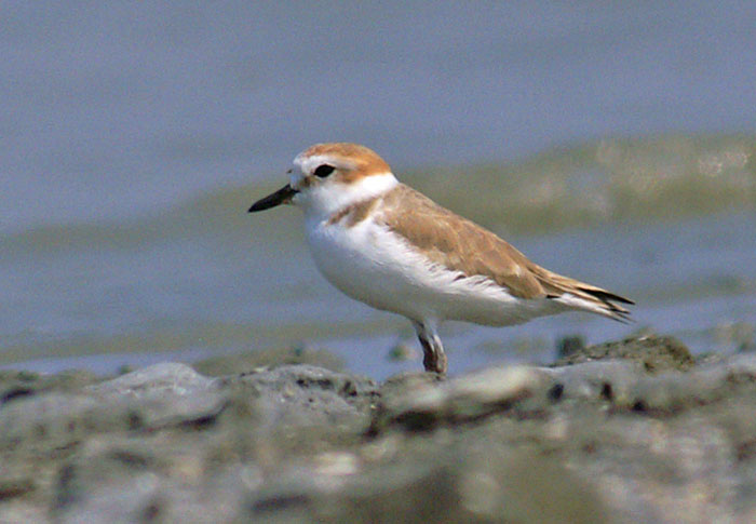
White-faced Plover, female in breeding plumage. (Malaysia; February 5, 2007.) © Dave Bakewell
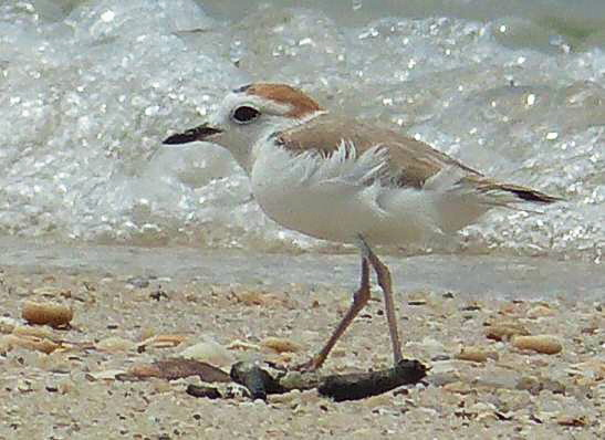
White-faced Plover, apparently a femaile in breeding plumage. (Langkawi, Kedah, Malaysia; February 2019.) © wendynatureguide
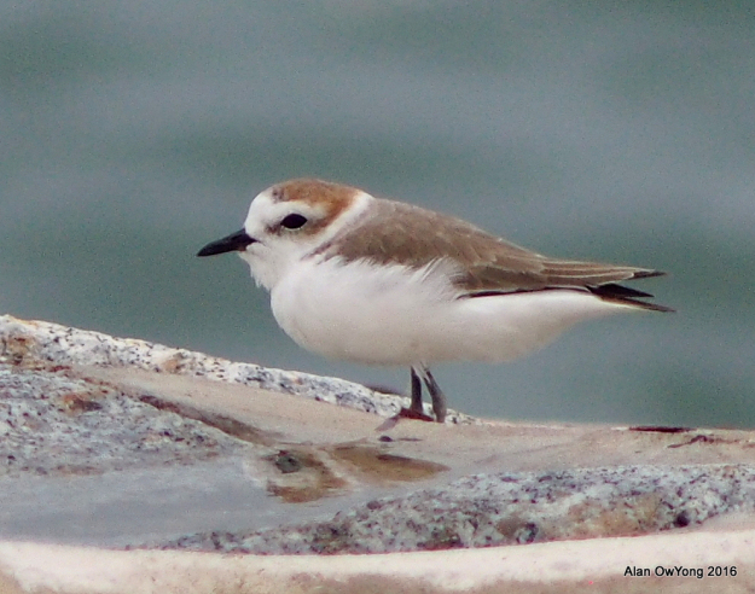
White-faced Plover, female in breeding plumage. © Alan OwYong

White-faced Plover, apparently an immature or female in nonbreeding plumage. (Rawai Beach, Satun, Thailand; November 17, 2017.) © Ayuwat Jearwattanakanok

White-faced Plover, immature or female in nonbreeding plumage. (Laem Pak Bia, Phetchaburi, Thailand; November 22, 2012.) © J.J. Harrison

White-faced Plover, apparently an immature or female in nonbreeding plumage. © Elis Simpson
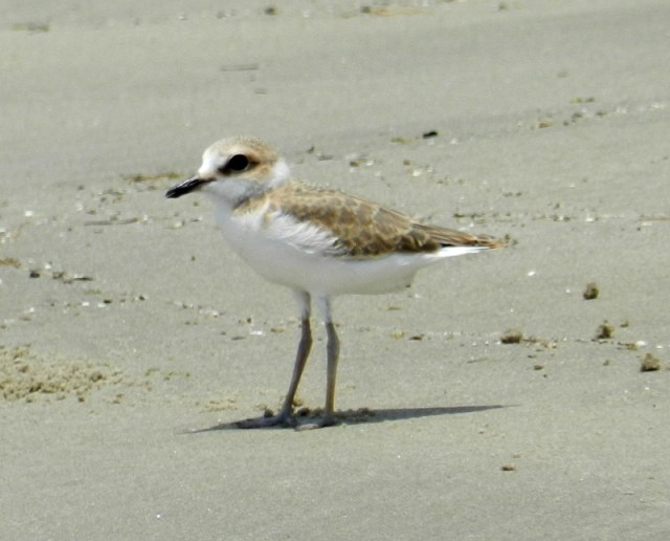
White-faced Plover, juvenile showing unusually dark patch around the eye. (Guangdong, China; May 2011.) © Brian Jones

White-faced Plover, female in breeding plumage, showing extensive white outer tail and wing-stripes. (Guangdong, China; June 18, 2011.) © Martin Hale
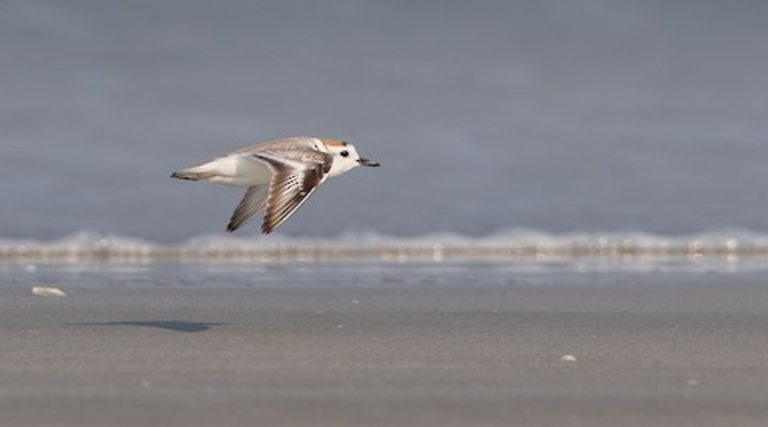
White-faced Plover, male in breeding plumage. (Laem Pak Bia, Phetchaburi, Thailand; February 20, 2017.) © Ian Davies
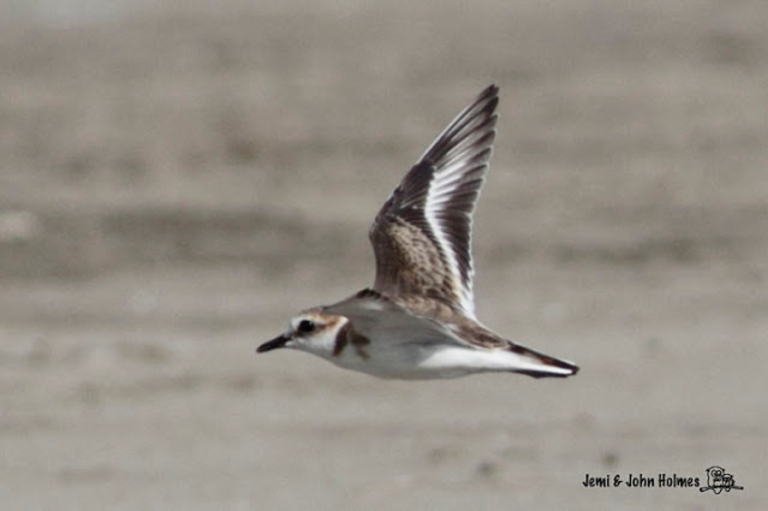
White-faced Plover, apparently a male in faded breeding plumage showing darker-than-average upperaprts. (Dahu Beach, Guangdong, China; June 2011.) © Jemi & John Holmes
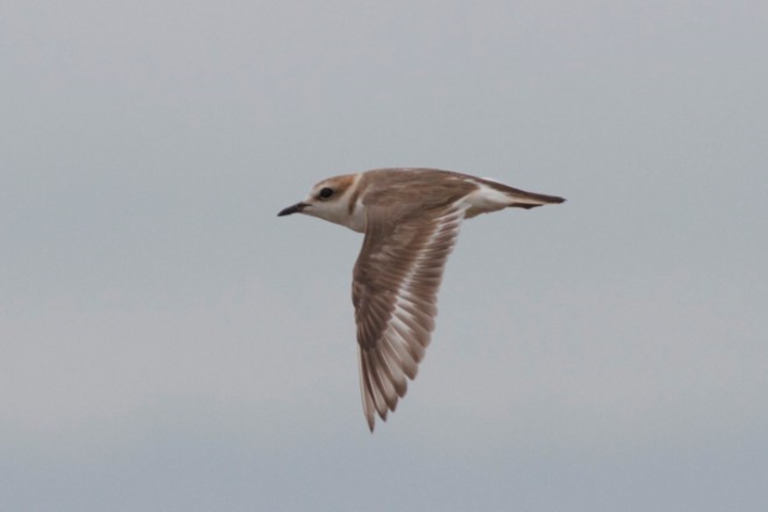
White-faced Plover, female in breeding plumage. (Fuzhou, Fujian, China; July 2012.) © Terry Townshend
Cf. Kentish Plover. White-faced Plover occurs entirely within Kentish Plover’s range. They winter together, often in mixed flocks, and Kentish migrates through White-faced’s breeding range. They share the same overall pattern, the same set of plumage types, and the same molt sequences. Plumages of both vary by season, sex, and age, so the relevant comparisons may require an assessment of these factors.
The main difference between them is that each of White-faced’s plumages is paler than the corresponding plumage of Kentish—although some Kentish Plovers are pale enough to be mistaken for White-faced, especially during transitional periods when multiple plumages of each species may be present.
The most reliably diagnostic feature of White-faced is the paleness of its eyestripe, which is almost always pale and indistinct enough that the black eye contrasts prominently. In comparison, Kentish’s eyestripe is usually dark enough that its eye becomes prominent only when viewed very closely.
Cf. Malaysian Plover. White-faced Plover winters mainly in areas where Malaysian Plover is resident. The potential for confusion is high because White-faced’s breeding plumage is extremely similar to Malaysian’s year-round plumage, and White-faced begins molting into this plumage early in the winter, while the two occur together. Although Malaysian does not show pronounced seasonal variation, its plumage varies by sex, age, and individual.
Malaysian Plover has a few key features that distinguish it from White-faced and Kentish:
Upperparts: Whereas White-faced and Kentish have mostly even-toned upperparts, Malaysian Plover’s upperparts have a subtly mottled appearance.
Hindcollar: Unlike White-faced and Kentish, Malaysian Plover has a dark hindcollar between its white neck-collar and back. On male Malaysians this collar is black and readily visible. On females and immatures the collar is rufous or chestnut, and darker than the rest of the upperparts.
Forecrown: Malaysian, White-faced, and Kentish Plovers all have a white forehead and darker crown, but on White-faced and Kentish the white is more extensive and includes the forecrown. On Malaysian, the white forehead is more limited and the forecrown is dark—so on male Malaysians the black bar on the crown is located farther forward than on breeding male White-faced and Kentish.
Eyebrow: Malaysian, White-faced, and Kentish Plovers all have a white brow line, but Malaysian’s is much shorter and typically does not extend behind the eye.
Eyestripe: Malaysian, White-faced, and Kentish Plovers all typically show some kind of contrasting eyestripe that varies by age, sex, and season. White-faced differs from the other two in having a paler, less complete eyestripe.
Notes
Monotypic species. Also known as Swinhoe’s Plover, and widely considered to a subspecies of Kentish Plover (C. alexandrinus), as discussed below.
IUCN Red List Status: Data Deficient.
Frontiers of Taxonomy: Does the White-faced Plover Qualify as a Separate Species?
The White-faced Plover presents a taxonomic conundrum. In appearance and ecology, it is readily distinguishable from Kentish Plover, but genetic analysis indicates that their divergence is too recent to support treatment as separate species. The question is whether their phenotypic differences outweigh their genetic similarity. Researchers who have studied the question closely—including the ones who performed the genetic analysis—have recommended full-species status for White-faced Plover, and both the IUCN and the Handbook of the Birds of the World Alive have accepted it. Some taxonomic authorities either disagree or await a broader consensus, but the trend is toward acceptance of the reclassification.
The Handbook bases its decision on the following features that differentiate White-faced from Kentish: “larger size, including thicker, blunter-tipped bill; white (not black) lores; more extensively white forehead, with black of crown usually reduced; brighter and paler upperparts; much-reduced black lateral breast patches; rufous-brown of crown not extending onto nape sometimes to divide hindcollar; more white in wingbar; also ecologically, occupying generally sandier, less muddy substrates.”
The story of the White-faced Plover is confused by a history of misidentification, as it belongs to a group of sand-plovers that closely resemble one another, with varying plumages that overlap in many features, and often winter in mixed flocks. In winter, the season of most observations, White-faced occurs together with typical Kentish and another similar species, the Malaysian Plover. Most individuals observed closely are assignable to one or the other, but there is an apparent spectrum of some potentially distinguishing features. As a result, many of the collected specimens were mislabeled and most old records (and some recent ones) are unreliable.
The pioneer of Asian ornithology, Robert Swinhoe, originally discovered and described the White-faced Plover in 1870, naming it Aegialites dealbatus. However, many subsequent specimens labeled as dealbatus were in fact representatives of the more-northerly-breeding Kentish Plover populations that winter with it, and thus the distinction was lost in inconsistent labeling and thereby obscured from the people who wrote the relevant modern reference books.
This situation held until the shorebird researchers Kennerley and Bakewell noticed that a few of the small plovers wintering on southeast Asian beaches seemed to have features of both Kentish and Malaysian Plovers and some that were unique to it—most noticeably the extent of white coloration on its face. They published their observations in 2008 and brought more widespread attention to the White-faced Plover. They concluded “that the White-faced Plover is probably a young lineage whose phenotypic traits are encoded by a limited number of genes, whereas few additional genomic differences have so far accumulated. Its diagnostic plumage traits may additionally be governed by differences in gene expression that would be undetectable by sequence analysis.”
A broad-based analysis published in 2011 confirmed that White-faced and Kentish are too closely related to show meaningful differentiation of the genetic markers that are usually used to assess relatedness—on these markers, White-faced clusters with Kentish, separate from their other closest relatives. But that paper went on to recommend separate-species classification on the strength of their differences in appearance. Considering that this group of plovers generally shows little observable differentiation even between forms that unambiguously qualify as separate species, the “local standard” should be to value the outwardly obvious differentiation of White-faced Plover.

White-faced Plover, a breeding male juiced up on hormones and flaring its white face. The impression this display conveys may indicate how the whiteness of the face would be favored in sexual selection, leading to a feedback loop where its plumage and behavior reinforce one another. (Laem Pak Bia, Phetchaburi, Thailand; February 24, 2019.) © Steve Arena
A possible “tie-breaker” in determining the status of the White-faced Plover would be to compare its breeding behavior with that of Kentish and assess the selection pressure that favors white-facedness. There is photographic evidence suggesting that the male flares its facial feathers in displays of aggression or attraction, and that the field of white feathers gives these displays a stronger effect. As a result, it seems plausible that the White-faced Plover would have developed distinct behaviors that emphasize this trait, causing it to diverge from Kentish in both coloration and behavior.
If research shows that Kentish Plover does not exhibit the same types of behaviors that emphasize facial coloration, that would seem to be a strong factor to include in the broader analysis of taxonomic status.
References
Bakewell, D.N., and P.R. Kennerley. 2008. Malaysia’s Mystery Plover. Surfbirds. https://www.surfbirds.com/Features/plovers1108/malayplovers.html.
BirdLife International. 2016. Charadrius dealbatus. The IUCN Red List of Threatened Species 2016: e.T22735615A95115530. https://dx.doi.org/10.2305/IUCN.UK.2016-3.RLTS.T22735615A95115530.en. (Accessed February 20, 2020.)
del Hoyo, J., N. Collar, G.M. Kirwan, C.J. Sharpe. 2020. White-faced Plover (Charadrius dealbatus). In Handbook of the Birds of the World Alive (J. del Hoyo, A. Elliott, J. Sargatal, D.A. Christie, and E. de Juana, eds.). Lynx Edicions, Barcelona. https://www.hbw.com/node/467300. (Accessed February 20, 2020.)
eBird. 2020. eBird: An online database of bird distribution and abundance. Cornell Lab of Ornithology, Ithaca, N.Y. http://www.ebird.org. (Accessed February 20, 2020.)
Kennerley, P.R., D.N. Bakewell, and P.D. Round, 2008. Rediscovery of a long-lost Charadrius plover from South-East Asia. Forktail 24:63-79.
Jones, B.I. 2011. A new breeding ground for White-faced Plover discovered in South China. BirdGuides. https://www.birdguides.com/articles/a-new-breeding-ground-for-white-faced-plover-discovered-in-south-china/.
Marchant, J., T. Prater, and P. Hayman. 1986. Shorebirds: An Identification Guide to the Waders of the World. Houghton Mifflin, Boston.
Rheindt, F.E., T. Székely, S.V. Edwards, P.L.M. Lee, T. Burke, P.R. Kennerley, D.N. Bakewell, M. Alrashidi, A. Kosztolányi, M.A. Weston, W.-T. Liu, W.-P. Lei, Y. Shigeta, S. Javed, S. Zafania, and C. Küpper. 2011. Conflict between Genetic and Phenotypic Differentiation: The Evolutionary History of a ‘Lost and Rediscovered’ Shorebird. PLOS One. https://journals.plos.org/plosone/article?id=10.1371/journal.pone.0026995.
